Content
- What is a pocket inhaler for?
- Device for individual pocket inhaler for asthmatics
- Types of devices
- Powder
- Freon aerosol
- Compressor nebulizers
- Ultrasonic
- How to use a pocket inhaler correctly
- Algorithm for using a pocket inhaler with a spacer
- Rules for the use of aerosol inhalers without a spacer
- Powder inhaler technique
- Rules and technique for using a pocket inhaler with a spray
- The technique of using a pocket inhaler in children
- Inhaler care after use
- Recommendations for use and storage
- Inhaler videos
The inhaler allows you to quickly remove spasm in the lungs and restore the breathing process. The device is available in 2 main types: stationary (used at home, including for the treatment of infectious pulmonary diseases, type the medicine used can be changed) and pocket (easy to use on the road, the medicine in the required dose is already placed in the device manufacturer). In this regard, the algorithm for the use of funds has differences.
What is a pocket inhaler for?
The drug looks like a small can and fits comfortably in the hand. Inside the device there is a medication that needs to be inhaled by pressing the valve located at the top or bottom of the inhaler. The composition used allows you to remove spasm, reduce pain symptom or inflammation in the airways.
Before starting to use the drug, it is important to exclude the patient's main contraindications, which include:
- body temperature above 38 degrees;
- frequent nosebleeds;
- coughing up blood;
- high blood pressure;
- violation of the composition of the blood;
- severe disorders of the heart and blood vessels.
In addition, the inhaler is not used for serious lesions of the lung tissue.
Device for individual pocket inhaler for asthmatics
Regardless of the composition of the drug used and the manufacturer's company, inhalers consist of the following elements: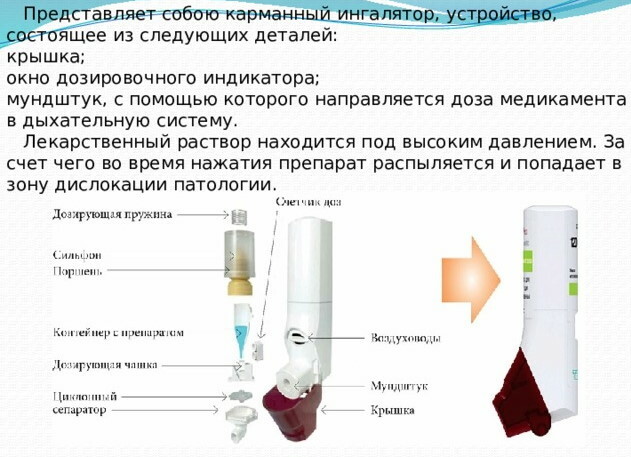
| Inhaler components | Appointment |
| Dosing device | The element allows you to select the required amount of the drug in one click. |
| Lid | Protects the mouthpiece of the inhaler from contamination. |
| Dose indicator | The detail displays how many doses of medication are left in the device. |
| Mouthpiece | The element directs the used medicinal composition into the respiratory tract. |
The medicinal composition (in liquid or powder form) inside the balloon is under strong pressure, due to this, after pressing the dispensing device, the agent immediately penetrates into the mouthpiece and further into the organs breathing. The simple system of use allows even small children to use the inhaler.
The choice of a pocket inhaler over a stationary one is due to the following advantages:
- small size, allowing you to carry the device with you and use it when an attack begins;
- ease of use (for dispensing, just press the valve);
- there is no need to fill the device with medication, it is already contained in the device.
Also, a pocket inhaler has a quick healing effect, eliminating a spasm or pain symptom.
Types of devices
The pocket inhaler, the algorithm of which is described in the article, is divided according to the drug used (composition and texture) and the method of drug delivery into the respiratory tract. The required type of device is selected strictly by a pulmonologist.
Powder
The medicinal composition in the inhaler is in powder form. When using the device, the components of the drug quickly penetrate the respiratory tract. The constituent products do not leave a taste in the mouth, since they do not settle on the oral mucosa. Due to the fact that the medicinal composition immediately penetrates into the lungs without settling in the mouth, it is convenient to dose it. This type of device is one of the most effective.
The disadvantage of a powder inhaler is its high cost.
Freon aerosol
The composition of the drug is presented in liquid form, therefore, when the medication is inhaled (moreover, the deeper the inhalation is, the more the agent will penetrate into the lungs), part of it settles on the mucous membrane. Due to the sedimentation of the drug in the oral cavity, it is impossible to accurately dose the drug, as well as in the mouth sediment remains, which is washed off with saliva and penetrates into the digestive tract, causing irritation mucous membranes.
The advantages of the inhaler include the affordable price and reliability of the device itself.
Compressor nebulizers
The devices deliver a metered-dose amount of drug, with each dose being a small dose. In this regard, the required amount of medication enters the respiratory tract. This allows us to classify this group of inhalers as highly effective. An additional advantage of the device is the absence of the need to control the inhalation, the drug penetrates into the respiratory tract in the required dose during any breath.
Of the disadvantages of the drug, a high cost is noted.
Ultrasonic
Ultrasonic inhalers dispense the medicinal composition due to sound vibrations of high frequency, and not due to pressing the dispenser. This allows you to accurately dose the medication. An additional advantage of the device is an increase in the local immunity of the respiratory tract due to the massage of the nasal sinuses, as well as the nasopharynx.
The disadvantage of the device is the high price.
How to use a pocket inhaler correctly
The pocket inhaler, the algorithm of which can be studied in the instructions for the device, is available in several types. The effectiveness of using the device depends on the implementation of the rules of "work" with the device, since there are individual characteristics for each type of device.
Algorithm for using a pocket inhaler with a spacer
The spacer is a small bottle-shaped attachment that makes the inhaler easier to use for children and also improves drug dosing. A mouthpiece or mask is attached to one side of the device, and the mouthpiece of a spray can on the other.
The composition of the drug penetrates into the respiratory tract only when inhaling, and when exhaling, the valves block the flow of the medication. As a result, when treating children, the correct dosage of the drug is noted, since they often cannot control the required breathing process when using an inhaler.

The subtleties of using an inhaler with a spacer are as follows:
- Wash the mask or mouthpiece, wipe off moisture thoroughly and secure the device to the spacer.
- Attach the mouthpiece of the balloon to the spacer and shake the structure well. After shaking, the drug composition will spray better.
- Fasten a mask on your face or grab a mouthpiece with your lips. The patient should sit up straight and keep the head straight.
- Next, you need to simultaneously press the balloon to trigger the valve, and take a deep and smooth breath for about 3-5 seconds.
- Remove the mask or remove the mouthpiece and hold your breath for about 10 seconds, then exhale through your mouth. Children can exhale directly into the spacer.
- Repeat breaths at the dosage prescribed by your doctor.
- After finishing the manipulations, rinse the mask (mouthpiece), spacer and disconnect the inhaler mouthpiece. Close the inhaler with a lid, and put the mask and mouthpiece in a special bag together with a spacer.
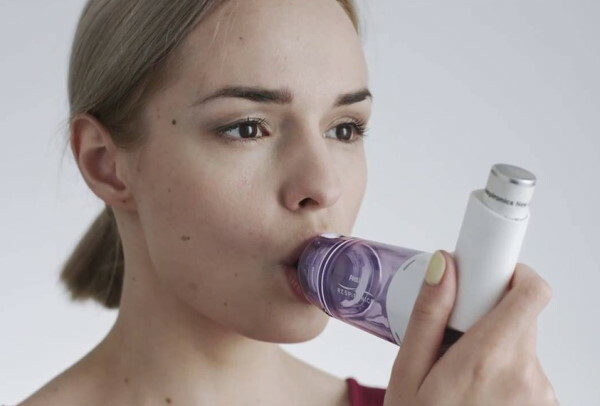 The main advantage of the spacer is the precise dosage of the drug into the respiratory tract. The disadvantage of the drug is not very compact size, so the tool is used mainly in stationary conditions.
The main advantage of the spacer is the precise dosage of the drug into the respiratory tract. The disadvantage of the drug is not very compact size, so the tool is used mainly in stationary conditions.
Rules for the use of aerosol inhalers without a spacer
The spacer is needed by the inhaler to facilitate dosing of the medication. But the device is optional. After training with a pulmonologist, the inhaler can be used without a spacer.
Features of using the inhaler without a spacer:
- Remove the protective cover from the mouthpiece, then wipe the mouthpiece dry with a clean cloth.
- Shake the inhaler well to evenly distribute the medicinal composition in the can and insert the mouthpiece into your mouth, clasping it tightly with your lips. Keep your head and neck straight.
- After that, you need to simultaneously inhale and press the inhaler lid. Inhale the medicinal solution gently.
- Remove the mouthpiece from your mouth, and hold your breath for about 10 seconds.
- Exhale smoothly through your mouth.
- The frequency of breaths of the medicinal composition from the inhaler is established by the doctor, and depends on the severity of the attack. It is recommended to re-inhale the medicine no earlier than 90 seconds later.
- Rinse the mouth with water to rinse off the remains of the drug.
- Wipe the mouthpiece with a dry cloth and close it with a protective cap.
The advantage of using a conventional inhaler is its compact size and efficiency (subject to the rules of use). The disadvantages of the device include compliance with the rules of inhalation and exhalation.
Powder inhaler technique
The algorithm for using the device with powder content practically does not differ from the rules for using an aerosol pocket inhaler.
Nuances of using a powder inhaler:
- Open the mouthpiece and wipe it off with a dry cloth.
- Shake the can to distribute the powder evenly inside.
- Grip the mouthpiece tightly with your lips.
- The position of the head, neck and back should be straight.
- At the same time, take a deep breath and press the lid of the device. You need to inhale the drug composition quickly, in contrast to an aerosol inhaler, which requires a slow inhalation.
- Hold the medicine in the air for about 10 seconds. Then exhale through your mouth.
- If necessary, repeat the manipulations from 4 to 6 points.
- Wipe the mouthpiece with a dry cloth and close it with a lid.
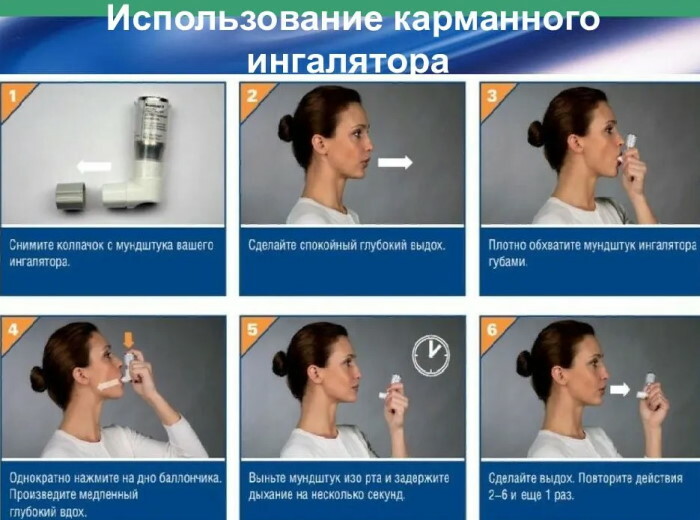
It is not necessary to rinse your mouth after the procedure, but experts recommend not to ignore mouth rinsing.
Rules and technique for using a pocket inhaler with a spray
The subtleties of using a spray inhaler practically do not differ from using an aerosol inhaler without a spacer. But there are some minor differences, which are described below.
Rules for using a spray inhaler:
- Remove the protective cap from the can, wipe the mouthpiece and attach it to the can.
- Shake the can so that the composition of the drug is evenly distributed.
- Take a deep breath in and out. After that, tightly clasp the mouthpiece with your lips. The bottle must be upside down.
- Tilt your head back slightly, and making a deep and smooth breath press the bottom of the can. You should press only 1 time, because if you press more, then a lot of medicine will remain in the oral cavity.
- Hold the air with the medicine for about 5-8 seconds. After that, remove the mouthpiece from the mouth and exhale through the mouth.
- Inhale without medication, after that, if necessary, repeat the manipulations the required number of times. An interval of about 5 minutes should be taken between breaths.
- Rinse your mouth with clean water.
- Remove the mouthpiece, wipe it and close the can with a protective cap.
It is important to achieve maximum therapeutic effect, it is required to shake the can thoroughly before each procedure.
The technique of using a pocket inhaler in children
The use of a pocket inhaler to normalize breathing in children is often difficult. Problems in application are caused by the difficulty of explaining to children the process of inhaling a drug by pressing the device. To control the use of the product, especially if the child is not yet 7 years old, the participation of parents is necessary.
The procedure can be facilitated by using a spacer. The device doses the medicinal composition so that it is not required to combine inhalation with pressing the inhaler. The child receives the correct dose of medication. In addition, the medicine practically does not settle in the oral cavity, and this is convenient because not all children know how to rinse their mouths.
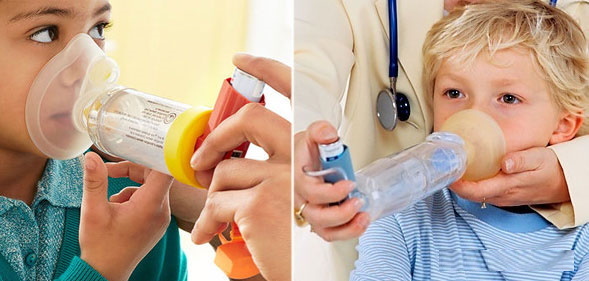
Rules for using the inhaler for children:
- Calm down the child, as the device may initially cause fright. It can be shown to an adult (it is not necessary to press the dispenser) that the device is safe.
- Wipe off the mask or mouthpiece and attach the element to the spacer.
- Install the inhaler into the spacer. Shake well beforehand.
- Place the child on your lap and keep the head and neck straight.
- Ask your child to breathe in and out smoothly.
- Wear a mask on the child or ask the child to take the mouthpiece in his mouth and press his lips tightly together. For children under 7 years old, it is better to use a mask.
- Ask the child to take 2-3 breaths, at this time the adult must press the inhaler dispenser.
- After 2-3 breaths, ask the child to hold his breath for at least 3-5 seconds.
- Ask the child to breathe out through the mouth.
- Repeat the manipulations after about 1 min. If they are needed.
- Ask your child to rinse out their mouth. If he does not know how, then you need to give a little water to drink.
- Remove the mask (mouthpiece) from the spacer, wipe it off. Also, disconnect the inhaler and close it with the lid.
After inhalation, monitor the child's condition for at least 30 minutes.
Inhaler care after use
A pocket inhaler, the algorithm of which can be checked with a pulmonologist, requires care. Since if you ignore this point, the device will quickly become clogged, and infection or dust may enter the lungs along with the drug composition. And since part of the drug is still swallowed with saliva, pathogenic microflora and dirt can penetrate into the digestive tract.
The inhaler care scheme consists of the following manipulations:
- After purchasing a new inhaler, the mouthpiece and mask must be wiped with a cloth with a disinfectant solution.
- After that, the mouthpiece and mask must be rinsed in clean water and wiped dry.
- Before use, it is enough to wipe the prepared mask and mouthpiece with a clean and slightly damp cloth.
- After using the device, you need to disconnect the mask and mouthpiece, and treat them in one of the appropriate ways:
- rinse the parts in a solution with hydrogen peroxide or with another disinfectant;
- boil the elements of the device for 20 minutes, but only on condition that the material does not deteriorate under the influence of high temperatures;
- keep the parts in an autoclave for about 15 minutes at a temperature of approximately 120 degrees. Also provided that the treated parts of the inhaler can withstand high temperatures.
- Rinse the disinfected mask and mouthpiece in boiled water and wipe off with a clean, soft cloth.
- Place the disinfected parts in a protective bag.
Important. It is impossible to sterilize the inhaler itself, only removable elements.
Recommendations for use and storage
The individual subtleties of application for each type of pocket inhaler were considered above.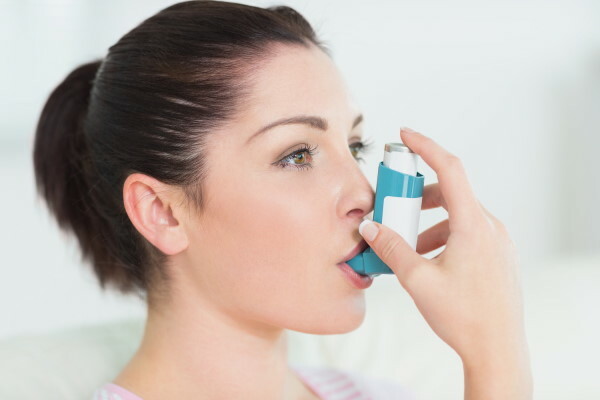
But before you start using them, you need to familiarize yourself with the following main subtleties:
| Key Features | Notes (edit) |
| Rinse the mouth well before manipulation. | It is required to remove food debris from the mouth so that they do not enter the respiratory tract. This item can be skipped in case of a severe asthmatic attack. |
| The inhaler must be turned upside down when dispensing | If the can is not turned over or kept in a horizontal position, it will not be possible to correctly dose the drug. |
| Disinfect removable parts before and after using the inhaler | Dust and pathogenic microflora can get onto the mask and mouthpiece both with saliva and during storage of the device. Therefore, ignoring this point may end in disastrous results. |
| Be sure to shake the can before each press. | When shaken, the composition used is evenly distributed in the inhaler. If the device is not shaken, then when pressed, the required amount of the drug will not penetrate into the respiratory tract. |
| Strictly adhere to the dosage prescribed by the doctor | If the dosage is violated, then the required result cannot be achieved from using the inhaler. Even if the rest of the rules for using the device are observed. |
| If the inhaler has not been used for a long time, then initially the drug stream must be directed into the air. | Manipulation is necessary to test the functionality of the instrument. And also with the first release of the drug composition from the hole in the inhaler, dust that could accumulate in it will be eliminated. It is necessary to check the expiration date of the inhaler. |
The algorithm for using the device should be studied not only according to the instructions, but also to clarify the rules for working with the device from the attending physician. Since ignoring, or ignorance of even an insignificant point (for example, do not close the device with a lid), can lead to serious consequences. Only compliance with all the rules for using a pocket inhaler will give the desired result.
Author: Kotlyachkova Svetlana
Inhaler videos
Algorithm for inhalation with metered aerosol:



